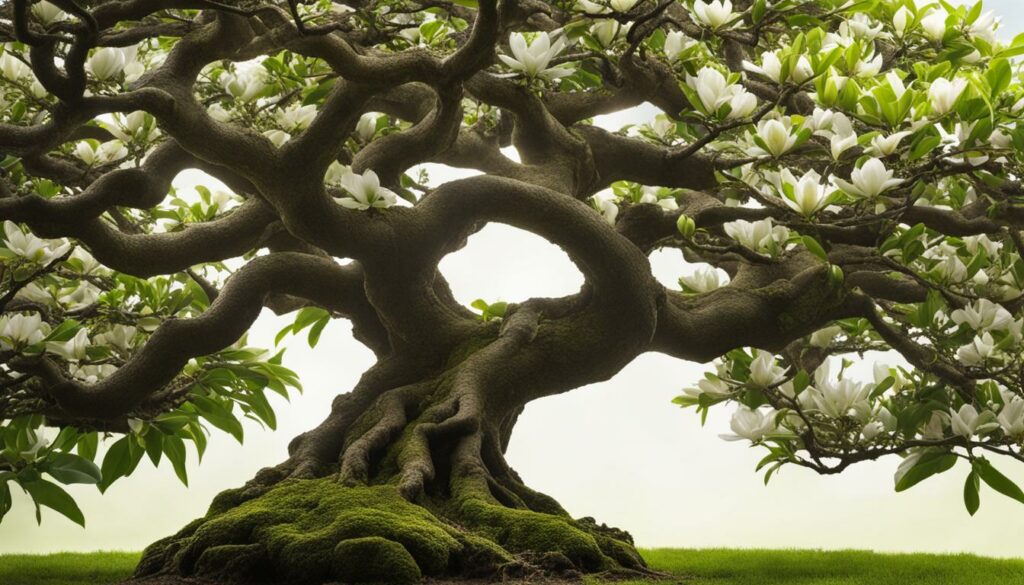Are you looking to add a touch of natural elegance to your home garden? Look no further than the Bonsai Tree Species Magnolia. With its stunning, large blooms and unique characteristics, cultivating a Magnolia bonsai in your own backyard is a rewarding experience for any bonsai enthusiast.
In this section, we will dive deeper into the world of Magnolia bonsai, exploring its appeal, different varieties, and practical tips for successful cultivation. Whether you’re a beginner or a seasoned pro, you’ll find valuable insights into adding this magnificent tree species to your collection.
Key Takeaways
- Magnolia bonsai is a stunning addition to any home garden
- There are various Magnolia bonsai tree species suitable for cultivation
- Cultivation of Magnolia bonsai requires attention to specific care techniques, including soil mixture, pruning, and fertilization
- Overwintering Magnolia bonsai in colder climates requires careful attention to temperature fluctuations and frost protection
- Proper care and attention to common issues can ensure your Magnolia bonsai thrives and blooms beautifully year-round
Understanding the Magnolia Bonsai Tree
The Magnolia bonsai is a stunning example of the beauty of tree species in the bonsai world. Its unique charm and elegance make it a popular choice among bonsai enthusiasts. These trees belong to the Magnoliaceae family and are native to East and Southeast Asia and the Americas.
What sets Magnolia bonsai trees apart from other bonsai species is their large, showy, and fragrant flowers. They bloom in various colors, from pure white to soft pink, magenta, or rich purple, making them a striking addition to any collection.
While the Magnolia bonsai tree has a visually appealing appearance, they also have distinctive characteristics that make them unique. These trees have an interesting bark texture, displaying a gray and tan, often with ridges, grooves, or horizontal markings.
Magnolia bonsai trees are known for their toughness, making them an excellent choice for beginners. They are hardy, immune to pests and disease, and adaptive to various environments. The tree species can grow up to 15 feet tall in the wild but can be easily maintained at a small size, fitting perfectly in small indoor or outdoor spaces.
Distinct Features of the Magnolia Bonsai Tree
Magnolia bonsai trees have unique features that make them stand out among other tree species. Their flowers are the most notable feature, large and vibrant, emitting a sweet fragrance. The foliage of the Magnolia bonsai tree comprises dark green, shiny leaves, providing a lovely contrast to the bright flowers when they bloom.
Another feature, as mentioned earlier, is its bark’s texture. The bark of the Magnolia bonsai is fascinating, with various furrows, ridges, and grooves. This characteristic gives it an artistic appearance, enhancing its aesthetic qualities.
Why the Magnolia Bonsai Tree is Unique
The Magnolia bonsai tree possesses a unique beauty that few other bonsai tree species can match. Their large, showy flowers make them one of the most striking and sought-after bonsai trees. Despite their adaptability to different environments and hardy nature, the Magnolia bonsai is relatively rare in the bonsai world, adding a sense of exclusivity to those lucky enough to own one. If you’re looking to add a unique touch of elegance to your bonsai collection, the Magnolia bonsai may be the perfect addition.
The Appeal of Flowering Bonsai
When it comes to bonsai, flowering varieties hold a unique appeal. They add a touch of natural beauty and elegance to any collection. The Magnolia Bonsai Tree is a particularly captivating species with its large, vibrant blooms that add a splash of color to your garden.
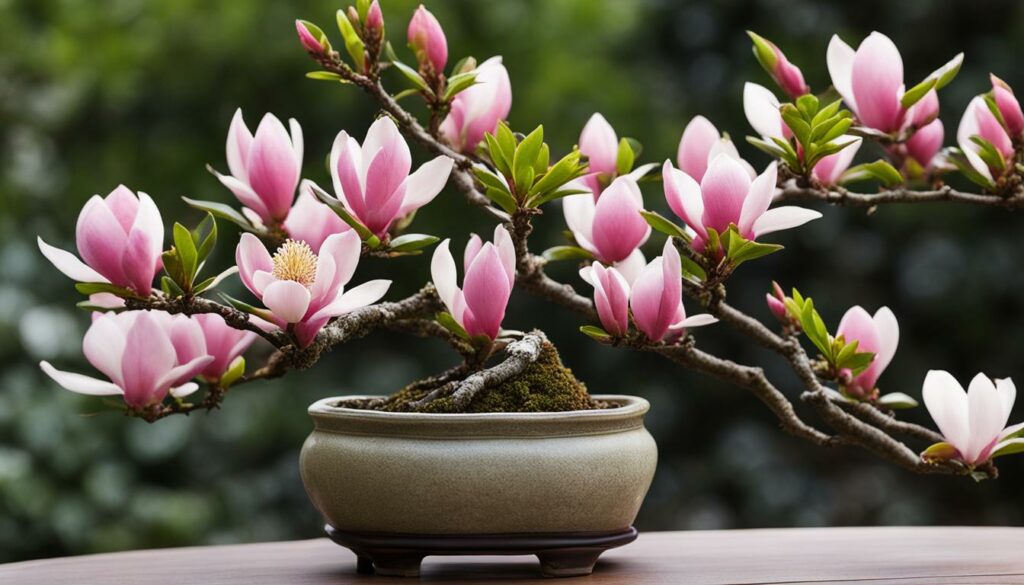
The elegant appearance of a flowering bonsai is matched by its ability to enhance the visual appeal of any space in which it is placed. The blooms of the Magnolia Bonsai Tree have a soft, delicate appearance that elicits a sense of tranquility and relaxation. Their large size further enhances their visual appeal, making them a standout species in your collection.
Whether you’re a seasoned bonsai enthusiast or new to this art, a flowering Magnolia Bonsai Tree is sure to delight and impress. Their unique beauty and versatile nature make them the perfect addition to any home garden or collection.
Magnificent Magnolia Varieties for Bonsai
Magnolia is a diverse family of flowering trees and shrubs with over 200 different species. When it comes to choosing the perfect Magnolia bonsai for your garden, it’s essential to consider the specific requirements and characteristics of each variety.
| Variety | Characteristics | Requirements |
|---|---|---|
| Magnolia grandiflora | Known for its large, fragrant white flowers and glossy evergreen leaves. | Needs full sunlight to partial shade and well-draining soil. |
| Magnolia stellata | Also known as the Star Magnolia, it has stunning white or pink flowers with star-shaped petals. | Requires regular watering and well-draining soil. Prefers partial shade to full sunlight. |
| Magnolia soulangeana | This hybrid variety features beautiful pink, purple or white flowers, and deciduous green leaves. | Needs well-draining soil and regular watering. Requires full sunlight to partial shade. |
| Magnolia liliflora | Also called the Lily Magnolia with a unique beauty and large, showy flowers in pink, purple and red tones. | Needs full sunlight to partial shade and well-draining soil. Requires regular watering and protection from frost and wind. |
Selecting the right Magnolia bonsai to cultivate in your home garden depends on personal preference, available space, location and climate. No matter which species you select, adding a Magnolia bonsai to your collection will bring a peaceful atmosphere and a stunning dose of color and vibrancy to your outdoor space.
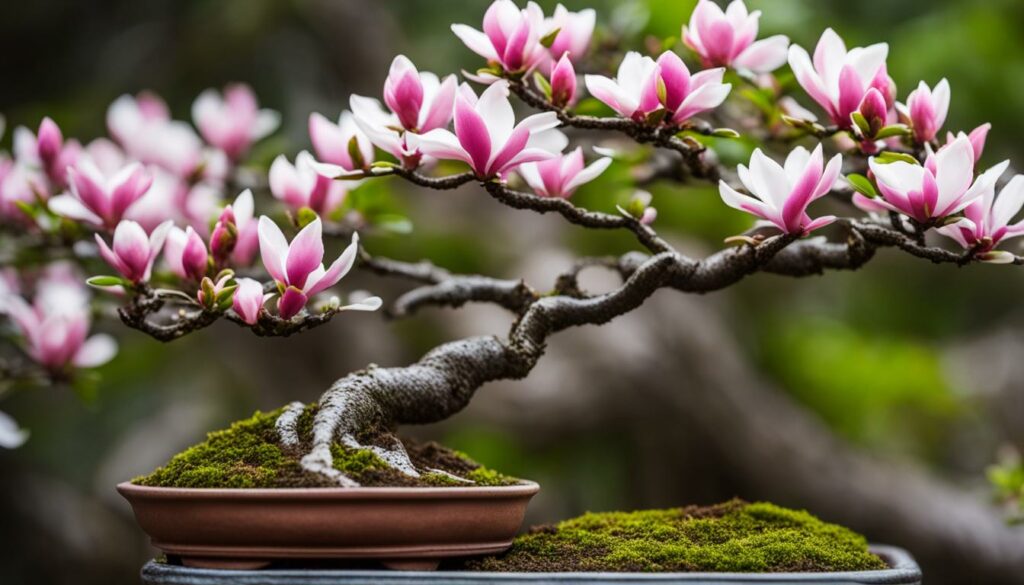
Cultivating Magnolia Bonsai: A Step-by-Step Guide
Now that you’re familiar with the unique appeal of Magnolia bonsai and the varieties you can cultivate, it’s time to dive into the essential steps for cultivating these beautiful trees in your home garden.
Step 1: Selecting the Right Pot
The proper pot is crucial for the healthy development of your Magnolia bonsai. Look for a container with drainage holes at the bottom to prevent waterlogging, and select a size that allows enough space for your roots to grow. Consider using an unglazed pot to aid moisture retention in the soil.
Step 2: Soil Mixture
Magnolia bonsai prefer a well-draining soil mixture that is slightly acidic. Consider using a mix of organic material, such as peat moss or compost, with equal parts of sand and perlite. This will create an optimal soil structure for your tree’s roots to establish and nourish.
Step 3: Watering Techniques
Watering is an essential aspect of cultivating Magnolia bonsai. Ensure your soil is evenly moist and avoid letting it dry out between watering sessions. Use a watering can with a narrow spout to avoid saturating the soil and causing waterlogging, which can harm your tree’s roots.
Step 4: Pruning and Pinching
Pruning and pinching are crucial for shaping and maintaining your Magnolia bonsai’s structure. Use sharp scissors or pruning shears to pinch off new growth, control branches, and maintain the desired form of your tree. Refrain from cutting off more than a third of the entire tree at once, as this can weaken its growth.
Step 5: Other Care Tips
Magnolia bonsai grow best with plenty of sunlight, preferably in a southern or western-facing location, and protection from harsh winds and frost. Consider fertilizing your tree once per month during the growing season, from late spring to early autumn. Keep an eye out for pests such as spider mites or aphids and take immediate action to prevent infestations from jeopardizing the health of your tree.
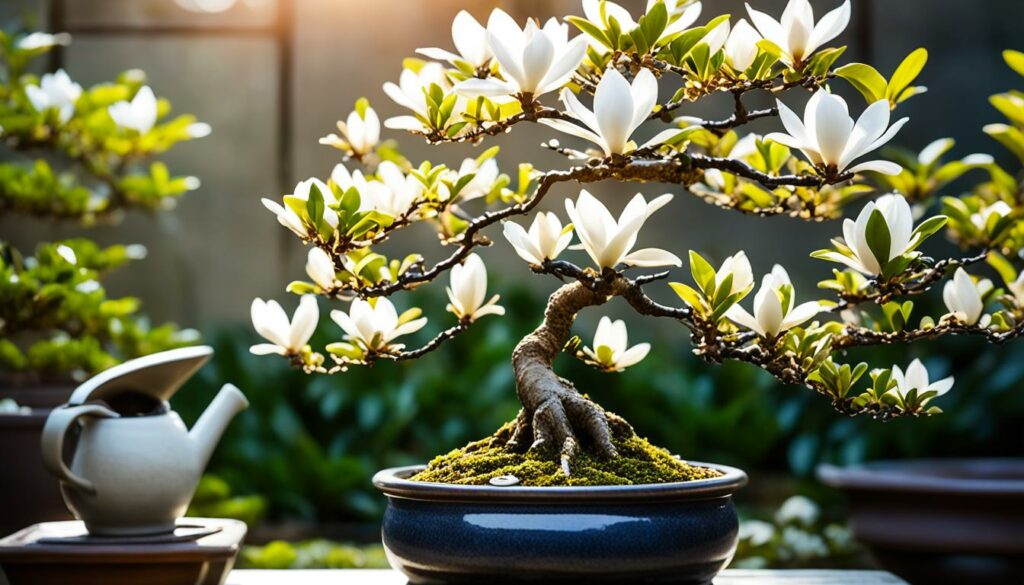
By following these steps and ensuring your Magnolia bonsai receives the proper care and attention, you can enjoy the beauty and elegance of these trees in your home garden for years to come.
Pruning and Shaping Your Magnolia Bonsai
Pruning and shaping are essential techniques that will enhance the overall structure and flowering potential of your Magnolia bonsai. By removing unwanted branches and leaves, you can redirect the tree’s growth pattern and create a more aesthetically pleasing form.
First and foremost, pruning your Magnolia bonsai should be done during the tree’s active growing season, in late spring or early summer when the new shoots are still pliable. Use a sharp, clean pair of pruning shears or scissors to make precise cuts. Avoid tearing or crushing the branches, as this can cause irreversible damage.
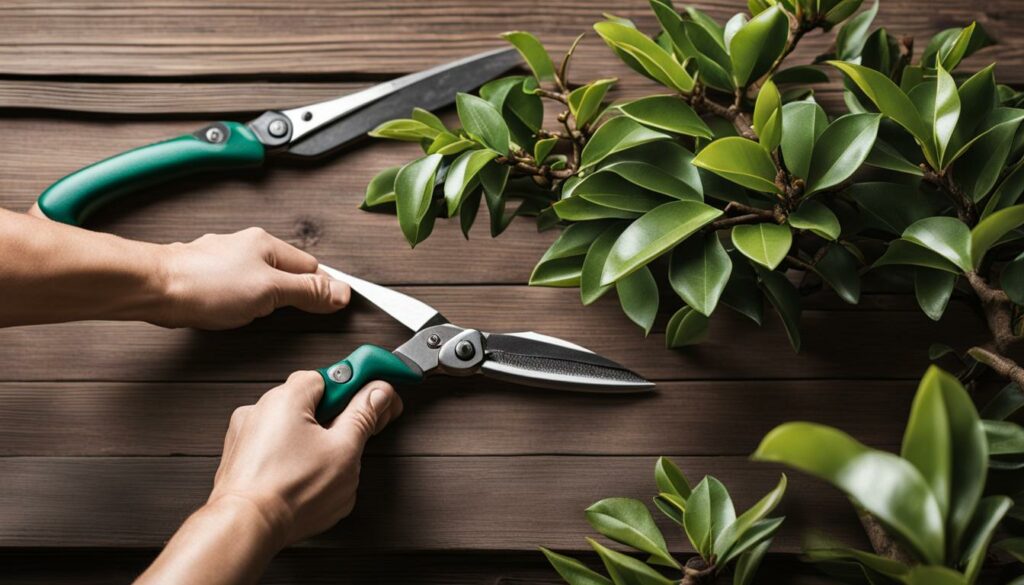
When shaping your Magnolia bonsai, consider the tree’s natural growth pattern and aim to enhance its unique structure. You can achieve various forms, such as formal upright or informal upright, by selectively pruning and wiring the branches. Wiring should be done in early spring or fall, when the branches are more flexible.
Ensure that you prune back to a bud facing the direction you want the branch to grow, as this will encourage new growth in the desired direction. Additionally, regularly removing any dead, diseased, or damaged branches will help maintain the overall health of your Magnolia bonsai.
Remember, over-pruning can harm your Magnolia bonsai and hinder its growth. Therefore, maintain a balance between shaping and allowing the tree to grow naturally. With proper pruning and shaping techniques, you can enjoy a healthy and stunning Magnolia bonsai that blossoms beautifully.
Caring for Blooming Magnolia Bonsai
Once your Magnolia bonsai starts to bloom, you’ll want to ensure that it remains healthy and vibrant. Here are some care tips specifically catered towards blooming Magnolia bonsai:
1. Provide Adequate Sunlight
Your blooming Magnolia bonsai requires plenty of sunlight to sustain beautiful and healthy blooms. Place your bonsai in a sunny spot, preferably where it receives morning sun and partial shade in the afternoon.
2. Water Regularly
Keep the soil moist but avoid overwatering your bonsai. Water around the base of the tree and avoid watering the leaves.
3. Fertilize Properly
Feed your Magnolia bonsai with a balanced fertilizer in the spring and summer months. Avoid fertilizing during the winter season when your bonsai is dormant. Be sure to follow the instructions on the package for proper application.
4. Protect Against Pests
Pests like aphids, spider mites, and scale insects can damage your blooming Magnolia bonsai. Monitor your plant regularly and take appropriate measures if you find any pests. Consider using insecticidal soap or neem oil to protect your bonsai.
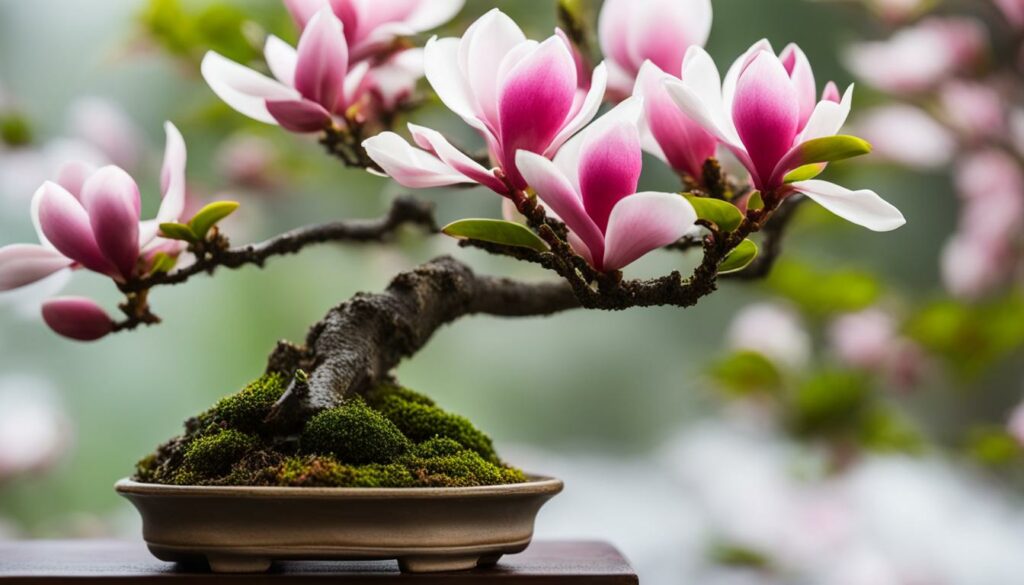
Now that you know how to care for your blooming Magnolia bonsai, keep in mind that regular care and maintenance are necessary to ensure that your bonsai blooms beautifully and healthily. With these tips, your Magnolia bonsai will thrive and add visual and natural beauty to your home garden.
Overwintering Magnolia Bonsai in Cold Climates
If you live in a cold climate, it’s important to take precautions to protect your Magnolia bonsai during the winter months. Without proper care, your bonsai could suffer from frost damage and temperature fluctuations.
The first step in overwintering your Magnolia bonsai is to prepare it for dormancy. To do this, gradually reduce the amount of fertilizer and water you provide your bonsai in the fall. This will allow the tree to slow down its growth and prepare for the winter ahead.
Next, choose a sheltered location where you can store your bonsai for the winter. A garage or shed that stays above freezing is ideal. However, if you don’t have access to a sheltered location, you can also bury your bonsai in the ground. Dig a hole deep enough to cover the entire pot and bonsai, and then cover it with mulch or leaves for insulation.
To further protect your Magnolia bonsai during the winter, consider wrapping the pot in insulation or moving it to a larger pot and surrounding it with mulch or hay. This will help keep the roots warm and prevent the soil from freezing.
Once spring arrives, gradually reintroduce water and fertilizer to the bonsai and move it back outside for the growing season. With proper care, your Magnolia bonsai can survive even the coldest winter climates.
Troubleshooting Common Issues with Magnolia Bonsai
If you’re experiencing issues with your Magnolia bonsai, fear not! Here are some common problems and their solutions:
Leaf discoloration
Yellowing or browning leaves are often a sign of overwatering or underwatering. Check the moisture level of the soil and adjust your watering accordingly. If the issue persists, look for signs of pest infestations or diseases.
Pest infestations
Common pests that can attack your Magnolia bonsai include spider mites, scale insects, and mealybugs. Use a mild insecticide solution and spray your bonsai every few days until the pests are under control.
Root rot
Overwatering can lead to root rot, which can eventually kill your Magnolia bonsai. If you suspect root rot, carefully remove the bonsai from its pot and examine the roots. Trim away any rotting roots and re-pot the bonsai in fresh, well-draining soil.
Inadequate sunlight
Magnolia bonsai require plenty of sunlight to thrive. If your bonsai is not getting enough sunlight, consider moving it to a sunnier location or investing in grow lights. Make sure to avoid direct sunlight during the hottest parts of the day.
Remember: Prevention is key when it comes to maintaining the health of your Magnolia bonsai. Regularly check for signs of pests and diseases, and adjust your watering and sunlight levels as needed. With proper care, your Magnolia bonsai will continue to thrive and bring beauty to your home garden.
Magnolia Bonsai: Bringing Elegance to Your Garden
Adding a Magnolia Bonsai to your home garden can bring a touch of natural beauty and elegance to your outdoor space. These stunning flowering bonsai trees are a popular choice among enthusiasts for their unique characteristics and captivating blooms.
With proper cultivation and care, your Magnolia Bonsai can become the centerpiece of your garden, drawing the eye with its large, vibrant flowers. Its unique beauty and elegance make it a perfect addition to any outdoor space.
Whether you’re an experienced bonsai cultivator or just starting, a Magnolia Bonsai is a must-have. With its distinct features and flowering potential, it’s sure to impress any guests to your home garden.
Don’t hesitate to add a bit of elegance with a Magnolia Bonsai to elevate the aesthetics of your outdoor space. Your garden will be the talk of the neighborhood with this exquisite bonsai tree.
FAQ
What is a Magnolia bonsai?
A Magnolia bonsai is a miniature version of a Magnolia tree that is cultivated through the art of bonsai. It showcases the beautiful and large blooms of the Magnolia tree in a compact and elegant form.
Can I grow a Magnolia bonsai in my home garden?
Yes, you can grow a Magnolia bonsai in your home garden. However, it is important to note that Magnolia bonsai trees require specific care and attention to thrive. It is recommended to research and understand their unique cultivation requirements before attempting to grow one.
Do all Magnolia bonsai trees produce large flowers?
Yes, one of the distinguishing characteristics of Magnolia bonsai trees is their large and vibrant flowers. However, it is important to choose the right Magnolia variety for bonsai cultivation, as different varieties may have slightly different flower sizes and colors.
Are Magnolia bonsai trees suitable for beginners?
Magnolia bonsai trees require intermediate to advanced bonsai skills and are generally not recommended for beginners. They have specific care requirements and need regular maintenance, including proper pruning and shaping techniques.
How do I care for a blooming Magnolia bonsai?
Caring for a blooming Magnolia bonsai includes providing it with ample sunlight, watering it properly, fertilizing it regularly, and protecting it from pests. Additionally, you should follow specific guidelines for blooming Magnolia bonsai to ensure the best flower production.
Can I overwinter my Magnolia bonsai in cold climates?
Yes, it is possible to overwinter a Magnolia bonsai in cold climates. However, extra care is needed to protect it from frost and temperature fluctuations. Insulating the bonsai, providing adequate shelter, and using appropriate overwintering techniques are essential to ensure its survival.
What are some common issues that can affect Magnolia bonsai?
Magnolia bonsai trees may face common issues such as leaf discoloration, pest infestations, and root rot. These issues can be caused by improper watering, inadequate sunlight, or incorrect soil conditions. Regular monitoring and prompt action can help address and resolve these problems.
How long does it take for a Magnolia bonsai to bloom?
The time it takes for a Magnolia bonsai to bloom depends on various factors, including the variety, age, and growing conditions. Generally, it can take several years for a Magnolia bonsai to reach maturity and produce its first blooms. Patience and proper care are crucial for achieving blooming success.
Can I shape and prune my Magnolia bonsai?
Yes, shaping and pruning are essential for maintaining the structure and aesthetics of your Magnolia bonsai. Proper pruning techniques, such as branch selection, thinning, and wiring, can help create desired forms and encourage healthy growth and flowering.
How can a Magnolia bonsai enhance my home garden?
Magnolia bonsai trees bring a sense of elegance and natural beauty to any home garden. Their large and colorful blooms provide a striking focal point and add visual interest. They can elevate the aesthetics of your outdoor space, creating a serene and captivating atmosphere.
